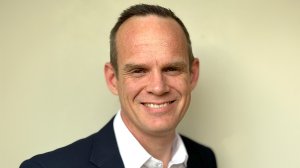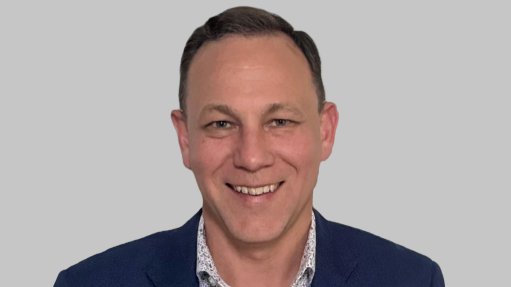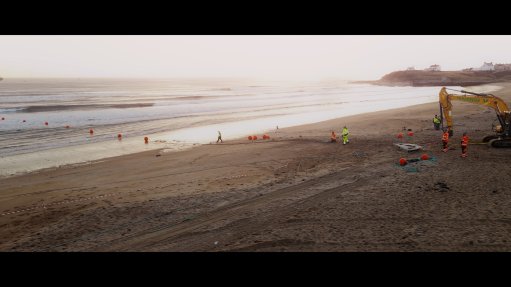High hopes for potentially game-changing technology at platinum group metal mines

African Rainbow Minerals Executive Growth Jacques van der Bijl interviewed by Mining Weekly's Martin Creamer. Video: Darlene Creamer.
Development of an innovative new mining method for narrow tabular steep dipping orebodies has reached an advanced stage after four years of effort.
The reef boring machine that has already been put through its preliminary paces is viewed as having the potential to boost platinum group metal (PGM) grades through more selective mining, which then lowers unit costs, enhances safety, streamlines downstream materials – and looks like also conceivably being able to slash the size, risk and environmental impact of tailings storage facilities.
Specialists in rock cutting technology, Herrenknecht and Master Drilling, were approached to independently develop rock cutting solutions for the production mining of upper group two (UG2) reef using a mechanised mining method with the potential for autonomous mining.
Now, rock around the clock, 24/7 mining, along with eventual potential surface- controlled automation looks like possibly being on the way in the not too distant future at two of South Africa’s narrow tabular orebody PGM mines on the eastern limb of the Bushveld Complex.
By targeting the high-grade upper group two (UG2) reef and minimising dilution, the mined stoping grade can be made to rocket by up to 60%.
The reef boring machines will be equipped with position sensing and steering capabilities to follow the UG2 reef horizon.
Interestingly, the new technology also comes with distinct downstream handling advantages and reduced tailings management costs, risk and, most importantly, environmental protection.
“I think this technology has the potential to be a game changer for the right orebodies,” African Rainbow Minerals (ARM) executive growth Jacques van der Bijl commented to Engineering News & Mining Weekly in a Zoom interview.
A reef cutting system has been custom designed to suit the UG2 reef layout of ARM’s Bokoni PGM asset. In addition to the cutting head, the reef cutting system comprises several units in the on-reef drive that are essential for supplying hydraulic power and drill rods to the cutting head, as well as for removing cutting material using vacuum suction.Reef boring using vacuum suction to transport rock cuttings allows for up-dip drilling. Initial results from concrete cutting trials are in line with performance targets.
The rectangular cutting section obtained from Master Drilling’s proposed cutter head design, which uplifts grades and production rates, was custom designed to suit the UG2 reef layout of not only Bokoni but also the Modikwa PGM mine.
Engineering News & Mining Weekly: What are the objectives that ARM set for this new reef boring development?
Van der Bijl: It’s been an interesting journey over the past four years. Our main goal was to find a mechanised mining solution to extract UG2 reef more selectively and efficiently, particularly in our narrow tabular orebodies at our Modikwa and Bokoni PGM mines, where nature has given us a gift with the PGM ounces concentrated in a very narrow, 60 cm reef width. However, due to limitations in technology and mining methods, we typically only end up mining at twice that width, about 120 cm, which leads up to 100% waste dilution. The surrounding pyroxenite waste does contain some PGM ounces, but not nearly as many as the UG2 reef. We explored various mining methods and ultimately chose reef boring as the best solution. This method allows us to mine high-grade reef selectively whilst minimising waste dilution, and it also offers the potential for mechanisation and eventual automation. However, one of the main challenges of reef boring, which has been extensively tried in the past, has been to achieve sufficient production volumes to make a meaningful and significant impact on the overall PGM production. For example, if a machine can only do 1 000 t to 2 000 t of high-grade reef a month, the PGM content recovered is too low to contribute meaningfully to the bottom line or the mine’s production levels. To overcome this, we have set ourselves a target to achieve the same productivity, safety and cost performance as a mechanised, low-profile bord-and-pillar operation in a narrow tabular body, such as Two Rivers mine. We based our targets on the performance of a typical mechanised, stoping crew at a bord-and- pillar operation where 15 000 t a month would be typically achieved, and in the case of Two Rivers, a grade of about 3.3 g/t, 6E, which provides the equivalent of about 50 kg of PGMs a month, or about 1 600 oz. With these objectives that we set ourselves, we would not only be mining selectively and eliminating waste, but also mining at a scale that positively impacts the overall production levels.
How did you approach the development of this technology?
As a PGM mining company, we know our design objectives and mining limitations, but we’re not experts in the mechanical aspects of developing reef boring technology. To bridge this gap, we partnered with Herrenknecht, a German company known for its excellence in designing and manufacturing tunnel boring machines worldwide, and also Master Drilling, a South African company that specialises in reef boring solutions. Most previous attempts of reef boring have been using a single circular profile. But to limit dilution, the diameter of a single circular profile can’t be much greater than the width of the reef horizon. In our case, at Bokoni and Modikwa, the single circular 60 cm diameter reef boring would result in quite a small cross sectional area, which then struggles to meet meaningful production levels with current technology in terms of how fast you can advance from a drilling perspective. To meet our production targets with a single cutter head design, the drilling rate would have to be up to three times higher than what’s currently possible with current drilling technology. To overcome this challenge, we started to evaluate various different drilling concepts against our goals. Herrenknecht then proposed quite an innovative solution to address the cross sectional challenge by using three overlapping cut heads in one frame, while Master Drilling focused on attaining a rectangular cut profile instead of a circular cut profile, which maximises reef extraction and minimises the waste dilution. Both approaches aimed at increasing the production and reducing waste. In developing these two concepts, a phased development approach was adopted, involving testing each aspect of the technology step by step. For instance, a hydraulic test frame was developed. This involved a single disc cutter head, which we took underground at one of our PGM mining operations, and mounted it against a mining pillar to thoroughly test the torque, thrust and penetration range for a single disc cutter on both UG2 and pyroxenite waste. The data that we then gathered from those tests have been valuable in designing the final cutting head design of the reef boring solution. By partnering with these two specialist companies and also taking a methodical approach to development, we were able to develop a technology that meets our specific needs while also leveraging the expertise of our partners.
Article Enquiry
Email Article
Save Article
Feedback
To advertise email advertising@creamermedia.co.za or click here
Comments
Press Office
Announcements
What's On
Subscribe to improve your user experience...
Option 1 (equivalent of R125 a month):
Receive a weekly copy of Creamer Media's Engineering News & Mining Weekly magazine
(print copy for those in South Africa and e-magazine for those outside of South Africa)
Receive daily email newsletters
Access to full search results
Access archive of magazine back copies
Access to Projects in Progress
Access to ONE Research Report of your choice in PDF format
Option 2 (equivalent of R375 a month):
All benefits from Option 1
PLUS
Access to Creamer Media's Research Channel Africa for ALL Research Reports, in PDF format, on various industrial and mining sectors
including Electricity; Water; Energy Transition; Hydrogen; Roads, Rail and Ports; Coal; Gold; Platinum; Battery Metals; etc.
Already a subscriber?
Forgotten your password?
Receive weekly copy of Creamer Media's Engineering News & Mining Weekly magazine (print copy for those in South Africa and e-magazine for those outside of South Africa)
➕
Recieve daily email newsletters
➕
Access to full search results
➕
Access archive of magazine back copies
➕
Access to Projects in Progress
➕
Access to ONE Research Report of your choice in PDF format
RESEARCH CHANNEL AFRICA
R4500 (equivalent of R375 a month)
SUBSCRIBEAll benefits from Option 1
➕
Access to Creamer Media's Research Channel Africa for ALL Research Reports on various industrial and mining sectors, in PDF format, including on:
Electricity
➕
Water
➕
Energy Transition
➕
Hydrogen
➕
Roads, Rail and Ports
➕
Coal
➕
Gold
➕
Platinum
➕
Battery Metals
➕
etc.
Receive all benefits from Option 1 or Option 2 delivered to numerous people at your company
➕
Multiple User names and Passwords for simultaneous log-ins
➕
Intranet integration access to all in your organisation

















